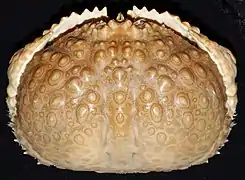Calappidae
Calappidae is a family of crabs containing 16 genera, of which 7 are only known as fossils:[1][2][3]
- Acanthocarpus Stimpson, 1871
- Calappa Weber, 1795
- † Calappella Rathbun, 1919
- † Calappilia A. Milne-Edwards, 1873
- Calappula Galil, 1997
- Cryptosoma Brullé, 1839
- Cycloes De Haan, 1837
- Cyclozodion Williams & Child, 1989
- Mursia A. G. Desmarest, 1823
- † Mursilata C.-H. Hu & Tao, 1996
- † Mursilia Rathbun, 1918
- † Mursiopsis Ristori, 1889
- Paracyclois Miers, 1886
- Platymera H. Milne Edwards, 1837
- † Stenodromia A. Milne-Edwards, 1873
- † Tutus Collins in Collins, Portell & Donovan, 2009
| Calappidae | |
|---|---|
 | |
| Calappa japonica seen from above; the front of the animal is at the top of the picture | |
| Scientific classification | |
| Kingdom: | |
| Phylum: | |
| Subphylum: | |
| Class: | |
| Order: | |
| Infraorder: | |
| Superfamily: | |
| Family: | Calappidae Milne-Edwards, 1837 |
Fossils within this family can be found in sediment of Europe, United States, Mexico, Central America, Australia and Japan from Cretaceous to recent (age range: 66.043 to 0.0 Ma).[4]
References
- Sammy De Grave; N. Dean Pentcheff; Shane T. Ahyong; et al. (2009). "A classification of living and fossil genera of decapod crustaceans" (PDF). Raffles Bulletin of Zoology. Suppl. 21: 1–109. Archived from the original (PDF) on 2011-06-06.
- Biolib
- Peter Davie (2015). "Calappidae". WoRMS. World Register of Marine Species. Retrieved 12 December 2015.
- Fossilworks
This article is issued from Wikipedia. The text is licensed under Creative Commons - Attribution - Sharealike. Additional terms may apply for the media files.